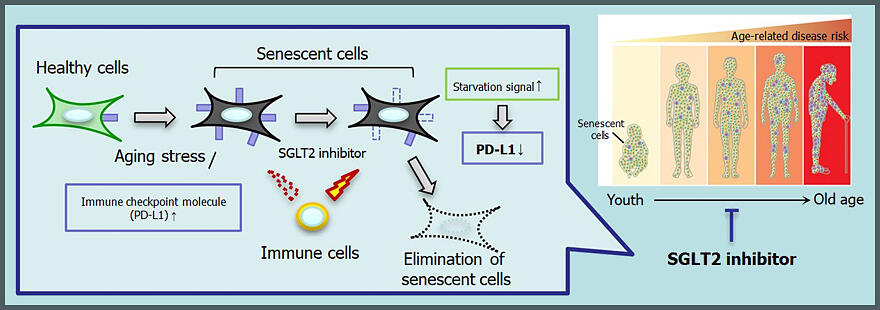A research group led by Project Assistant Professor Goro Katsuumi of the Department of Internal Medicine and the Department of Cardiovascular Biology and Medicine of the Faculty of Medicine, and Professor Tohru Minamino of the Department of Cardiovascular Biology and Medicine of the Graduate School of Medicine at Juntendo University, has announced their research findings showing that an SGLT2 inhibitor, a therapeutic drug for diabetes, serves as a senolytic agent and has clarified its mechanism. In mice treated with the inhibitor, senescent cells were eliminated and age-related frailty improved. They confirmed that elimination of senescent cells from atherosclerotic plaques reduced the atherosclerotic plaque size and prolonged the lifespan of mice with premature aging. The inhibitor is expected to be applied as a therapeutic agent for various aging-related diseases. The results were published in the May 30 issue of the international journal Nature Aging.

SGLT2 inhibitors improve chronic inflammation by activating the immune system, which is responsible for senescent cell removal, resulting in the removal of these cells.
Provided by Juntendo University
After rounds of cell division and detection of chromosome damage, cells stop dividing and become senescent. The accumulated senescent cells eliminate themselves by secreting SASP factors (inflammatory molecules) that activate the immune system, serving as a cancer-suppressing mechanism. Because this capacity declines with aging or disease, various aging-related diseases occur as a result of chronic inflammation of tissues. Experiments in mice have shown that the removal of senescent cells prolongs lifespan and prevents cancer. Drugs that specifically eliminate senescent cells are being developed worldwide. Meanwhile, caloric restriction is known to prolong the lifespan of various animals and has been reported to decrease the accumulation of senescent cells.
In this study, the research group examined whether an SGLT2 inhibitor used for the treatment of diabetes could mimic caloric restriction. SGLT2 inhibitors lower blood glucose levels by increasing the urinary glucose excretion. In the experiment, obese mice fed on a high-fat diet for 8−10 weeks were treated with an SGLT2 inhibitor for a short duration. The treatment eliminated senescent cells accumulated in visceral fat and ameliorated inflammation. Blood glucose levels decreased, and glucose intolerance and insulin resistance improved. In contrast, insulin treatment did not have this effect. Furthermore, they treated middle-aged mice with the inhibitor to determine the effects on physical activity and found that the progression of frailty was decelerated.
In mice with premature aging, the inhibitor treatment significantly prolonged the lifespan. To elucidate the mechanism underlying these effects, they focused on the metabolic alterations induced by SGLT2 inhibitor administration. Metabolomic analysis of metabolites revealed that AICAR, which activates AMPK (adenosine monophosphate-activated protein kinase), rapidly increased after administration. Moreover, AMPK activation suppressed an immune checkpoint molecule (PD-L1), the expression of which is elevated in highly malignant senescent cells. These findings showed that the SGLT2 inhibitor treatment promotes the elimination of senescent cells by activating the immune system responsible for the mechanism of senolysis.
Journal Information
Publication: Nature Aging
Title: SGLT2 inhibition eliminates senescent cells and alleviates pathological aging
DOI: 10.1038/s43587-024-00642-y
This article has been translated by JST with permission from The Science News Ltd. (https://sci-news.co.jp/). Unauthorized reproduction of the article and photographs is prohibited.




